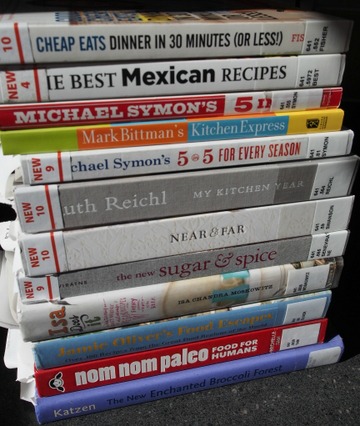When I was offered the opportunity to read and review “What the Fork Are You Eating?” I knew it was right up my alley! There’s so much information — and misinformation — out there about our food, I’m always interested in brushing up on how to make the healthiest choices about the foods I’m eating and feeding my family.
And “What the Fork” delivers! Author Stefanie Sacks pulls back the curtain on the marketing ploys Big Food employs to make us think their products are wholesome — when they’re really not.
The book includes:
- the top 10 things in or on our food that can cause harm to our bodies — and how to get them out of our diet
- how to decode misleading food labels
- simple strategies to rehab your pantry, fridge, and freezer
- an aisle-by-aisle guide for how to shop for healthier foods
- and 50 original whole-food recipes!
Interested? I’m giving away a copy of the book below! But first, check out this conversation with author Stefanie Sacks.
While the US government defines many of the claims and terms on food packages today, they don’t effectively regulate what food companies are really doing— meaning many labels are misleading and completely unregulated. What are 3 key examples of misleading food labeling lingo that buyers should beware?
There are too many misleading labels to count but the ones that most commonly dupe the consumer are “Natural”; “Cage-Free”; and “Sustainably Farmed/Raised.” While all are loosely defined by the FDA/USDA, none are effectively regulated.
2. You are the mother to two young sons, Hunter and Jack. Do they have any food allergies or intolerances?
Hunter has gluten sensitivity. Other than that, we can pretty much eat anything. And we do, but always with the understanding of where our food comes from and what is in our food. My kids eat candy just like most kids, but other than celebrations and a jaunt to the movies, the candy they eat is void of anything artificial. So long as they eat meals and snacks that have real food as the centerpiece, sweets and treats are permissible. We often cook together (especially on weekends) and eat together as many nights per week as we can where we sit down as a family and talk about the food, our days and more.
3. Growing up, you suffered from an onslaught of health issues: asthma, allergies, recurring bronchitis, and pneumonia. What role did food play in the healing process?
Food was central to my healing process. It was at the age of 17 that a doctor put me on a candida diet (a yeast, dairy, ferment and sugar free regimen) and within 1-2 months, I was off 5 different medications. That marked the beginning of my true understanding as to how diet could help me get well and feel better. And it did! During my teens and twenties I explored different food practices like veganism, vegetarianism and macrobiotics. I also tried “fads” like the blood type diet. In the end, eating a diet founded in whole pure foods, always knowing where my food came from, was what led me to wellness. Yes, I have certain dietary needs now like a gluten-free diet (as well as a low sodium, high potassium and low oxalate diet to help manage a kidney disease I live with) but what keeps me healthy is eating a wide variety of real food in moderation.
4. Big Food corporations often own smaller brands that were doing the right thing (for example, General Mills, notorious for Betty Crocker, also owns two of your favorite brands, Cascadian Farms and Muir Glen). If a big food company swallows the smaller, better, brand – does that mean the quality of the product will go down?
It doesn’t necessarily mean that the quality of the product will diminish but you have to ask yourself how Big Food—those at the forefront of innovating processed food with little care about human health and environmental impact—will in fact manage (and grow) this acquisition while maintaining integrity and keeping true consumer health at the center. To learn about the Big Food companies that have acquired the “good guys” you can check out Who Owns Organics. In terms of what to look out for, unless you study a product day in and day out, you may never know if ingredients are changed but you can understand what is in your food with EWG’s Food Scores Database.
5. Sports drinks, energy bars, and many other foods found in health stores and marketed to health-conscious consumers are full of top rated “terminators”: soy protein isolates, artificial colors, large amounts of sugar and its many euphemisms. What are some better-for-you alternatives?
In terms of sports drinks, opt into coconut water or a new beverage called Titan Tea. Both don’t come with too much sugar or artificial sweeteners (among many other offenders). As far as the bars go, I like those that have 5 ingredients at best coming from real food (so nuts versus soy protein isolates). Kate’s Real Food Bars, Health Warrior Chia Bars, Oskri Bars, Bumble Bars and even some Kind Bars are better options.
6. Your book is packed with takeaways and tips. What are 3 quick and simple things readers can start doing today to make a change for the better?
- Understand that the ingredients tell the real story of your food (not the nutrition facts or all of the health claims).
- When it comes to animal foods, unless you see third party verification by Animal Welfare Approved, Certified Humane, USDA Organic or Certified Naturally Grown, you really can’t trust any of the label lingo like “cage-free”.
- Understand that even small changes in food choice can make big everyday differences. In other words, don’t beat yourself up for what you can’t do; rather, applaud yourself for what you can do!
Ready to learn more?
Enter to win your own copy, courtesy Tarcher/Penguin Paperback, using the widget below!
Penguin provided us a review copy of the book and offered to give away a second copy to our readers, but we were otherwise not compensated for this review and all opinions are our own!






I am excited about getting and reading this book. It is right up my alley
I work with kids in a very rural community where their families are way below the poverty line. One of the things I have been working on is teaching the kids about nutrition and making choices and even making their own meals (on a budget/ with what they have) and would love to know if you have any recommendations/resources you'd like to suggest.
Also, thanks for the opportunity to win a copy of this book and for the Q&A!
This looks like a great book,i’m always looking for new books on healthy eating